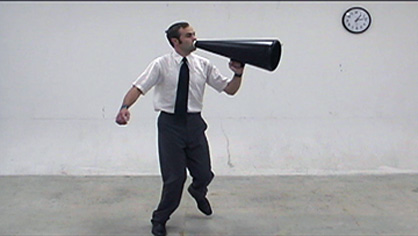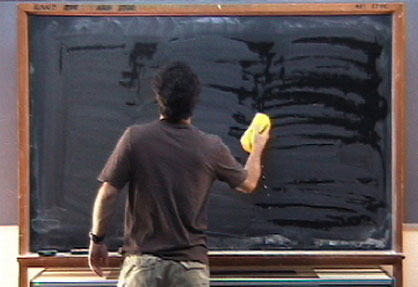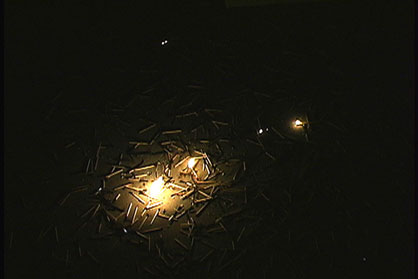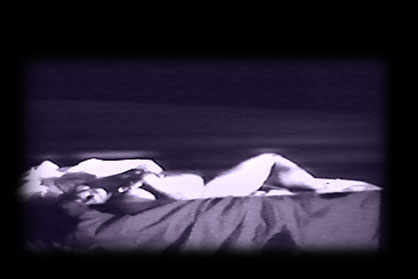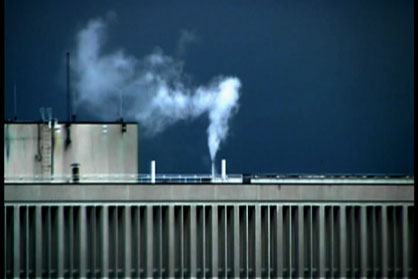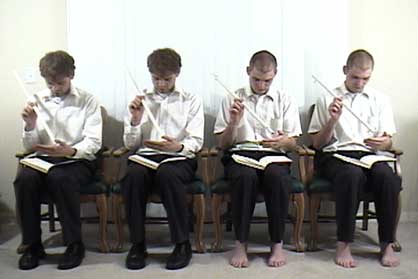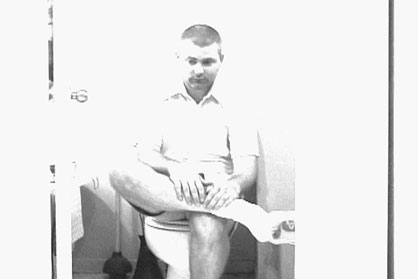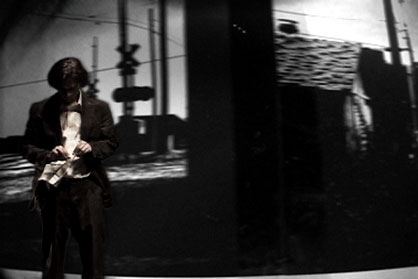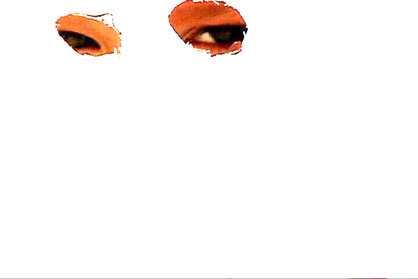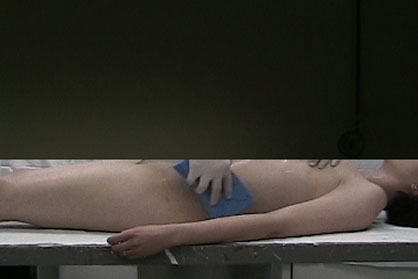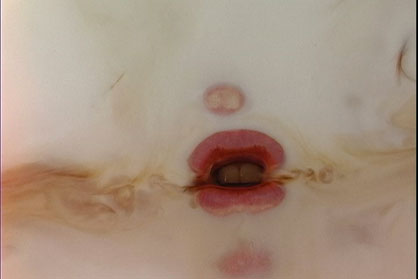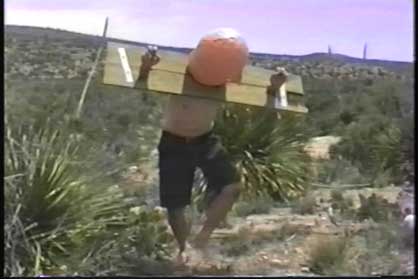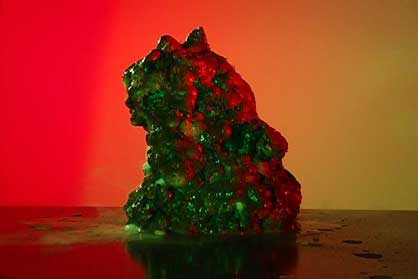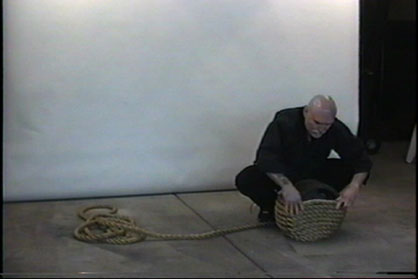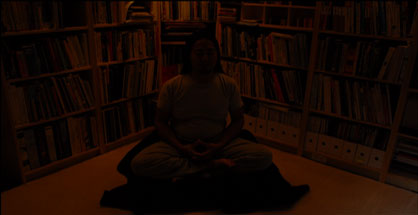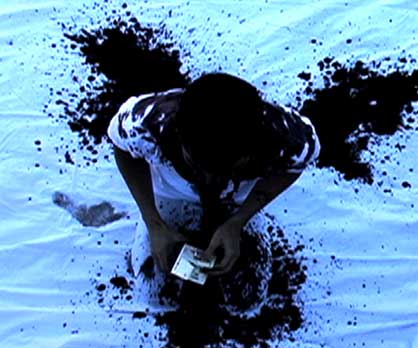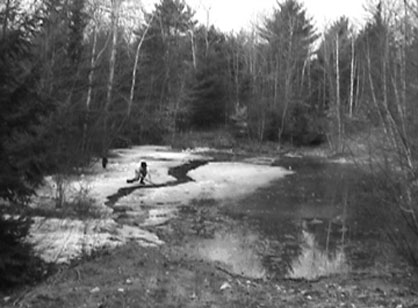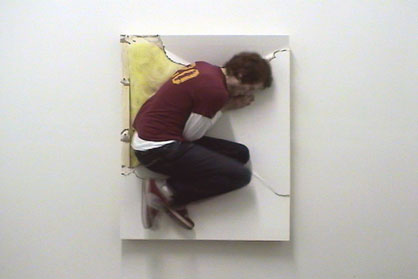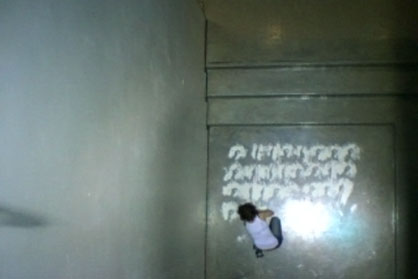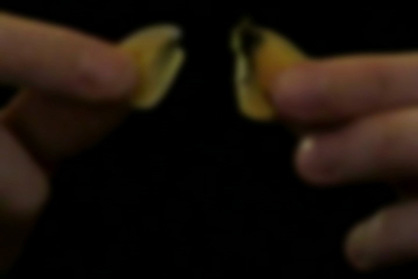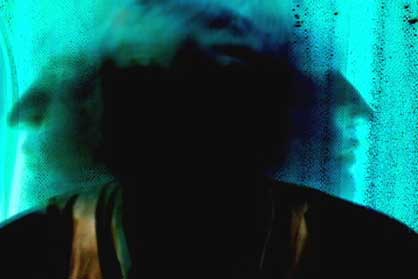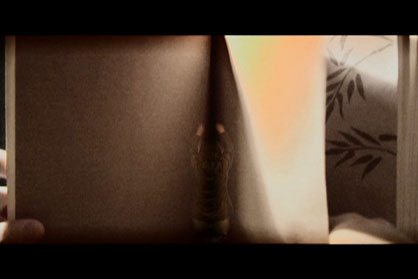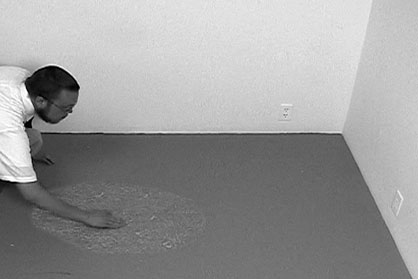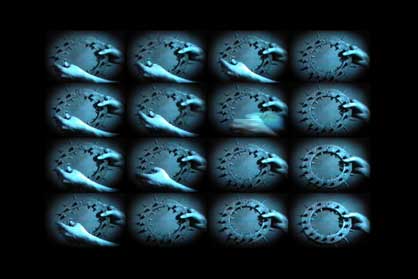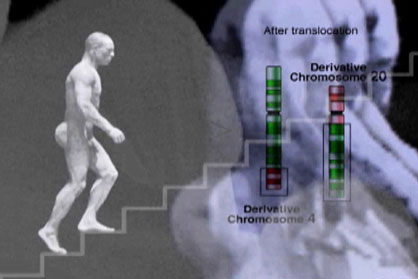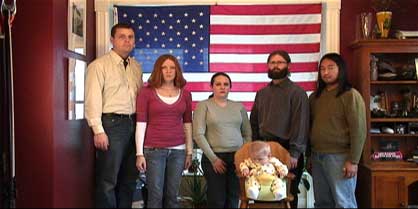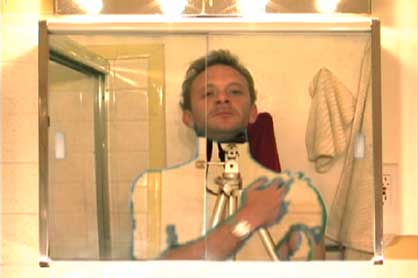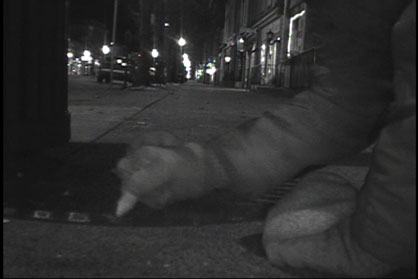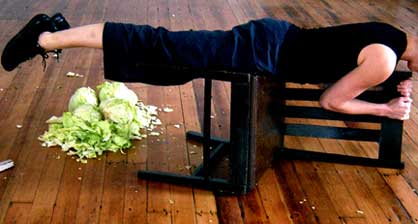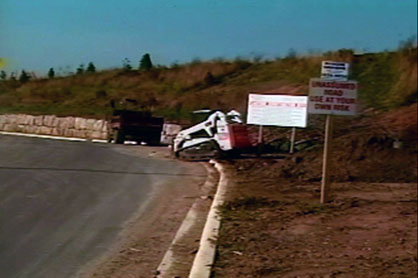Filed under: Ritual and Repetition
Loud and Clear, 2006
1:30 min excerpt – Full Running Time 61:30 minutes
Dietmar Krumrey – Mt. Pleasant Michigan
Loud and Clear is an hour long performance piece where, dressed in a shirt, tie and expensive shoes, I spin in circles while shouting “Attention!” into a large black megaphone and a clock ticks off the seconds in the background. It is a repetitive action that at once appears totally absurd, but if seen as a metaphor of communication in all its dizzying ceaselessness. The work exemplifies something much more ordinary, realistic and is down-to-earth.
Filed under: Ritual and Repetition
Clean Slate, 2006
4 mins
Michael Sherwin – Ellensburg Washington
After my first year of full-time teaching as a Professor of Photography at Central Washington University I was exhausted. I walked around the empty classroom sifting through all the ups and downs of the past year. I had thought four courses a term, including six sections of Beginning Photography alone. So many students, so many faces, and so many questions crisscrossed my muddled mind. I was burnout, beaten, and numb. The repetition of courses and endless stream of students only seemed to gain intensity with each subsequent term. How does a teacher handle the constant process of renewal?
As I reflected on the challenges of my new chosen profession, I looked around the classroom hoping to find some symbol of my effort. My eyes fell on the old slate chalkboard sitting in the corner of the classroom. A reservoir and device for the transmission of information, my chalkboard had not been cleaned in an entire year. Like a cumulus cloud drifting slowly overhead I stood and stared at this abstract representation of time passed. Embedded in the thick dust lied the signs and hazy reminders of my mechanical reiteration.
In an act of determination and restoration, I decided to document myself cleaning the chalk-dust off the board with a big wet sponge. Condensing 30 minutes of repeated attempts to cleanse the board just into 5, each of the infinite patterns formed in the drying dust trace the residue of my rapid actions, resembling a temporal abstract expressionist painting. The piece serves as a process of mental cleansing and as a simple symbol for repetition, ritual and renewal.
Filed under: Ritual and Repetition
Fireflies, 2003
5 min excerpt – Full Running Time 11:55 mins
Joe Nanashe – Brooklyn New York
To record is to see, to quantify. Moments pass before the lens to be forever repeated. Memory no longer exists outside of the context of records. This is the trap we have established. To preserve we must kill. Video is the most purgatorial method of documentation. The recorded figure is unable to respond yet continually being. The revolution of the assembly line paved the way for this condition. Industry broke down the body at speed unprecedented in human history and the advent of moving imagery captured and normalized the systematic violence against the figure.
Created just after the invasion of Iraq in 2003, Fireflies is a meditation on the generative powers of fire, the fragility of existence, the beauty of destruction, and the mediation of war and violence. As the blue tipped matches are shot across the floor, the fleeting burn of fire illuminates the shot, giving brief glimpses of the overall decimated landscape. The rectangular shot of the camera becomes the ritual space for the repetitive gesture.
Filed under: Ritual and Repetition
L’entre deux
1:31 excerpt
Sylvie Bélanger – Toronto Ontario Canada
My work stems from a nomadic aesthetic, immersing images, sounds and the visitor in a sort of collage. It’s a collage, which constantly redefines ambling spaces, through aimless video loops combined with sounds and silences that interrupt the flow of images. It’s a collage that deploys a resistance to fix defined positions, both in space and in time. The fluidity of the visual and sound spaces sets the stage for a view of the subject, which is in a state of constantly becoming. It is a vagrancy, where my motive force, is a visual and auditory movement, one that affectively rests in the viewer and never on the screen. It orients, disorients, links and ruptures sound and image in fluid variations, one that loops in the end, as discontinuously as any contemporary attempt at fixing in time or space our personal subjectivity.
The work originates in an investment of the subject as agent, meaning a multiplicity and multidimensionality of its positions in relation to art’s discourse, its investment and of its political powers to resist, to criticize and to contradict. It is a space evoked by but also remote from structures, language and articulated experience. It’s a dialectic space between presence and absence, which I like to call “ailleurs” (the elsewhere) – a space situated at the intersection between the real and its metaphor. In this context, I will say that Art is largely social for me because it resuscitates again and again, our fears or desires, our hopes and anxieties, recording through itself our struggles as people who are acting at once in relationships to each other and living in a world that has its own relationships.
Filed under: Ritual and Repetition
Collusion, 2003
with sound design by George Cicci
3 min except – Full Running Time 20 mins
Christopher Coleman – Eugene Oregon
Collusion consists of a full wall projection of industrial expulsions that have been time-manipulated so that the vents seem to be sucking in the smoke in rhythmic breaths. Large amounts of smoke are drawn from the sky followed by a pause and small release before another inhalation begins. The sounds of machinery quickly take on a natural cadence that compels the viewer to breath with the factory. Just when all the smoke seems to have been withdrawn, more materializes from the blue sky in a never-ending deluge. As an enveloping installation, a connection is quickly made between the breathing of the viewer and the piece. It speaks not only of hope and hopelessness but control and our own complicity in what is happening to the world around us.
Filed under: Ritual and Repetition
Composition for Two Lengths of PVC Pipe, 2005
19 seconds
Neal W. Cox – San Antonio Texas
The work entitled Composition for Two Lengths of PVC Pipe is a work of percussive “music” (I use this term losely, as I am not a musician) related to the specific geometry of a particular geodesic dome. It is the audio/video component of a larger work using a dome built as a system designed to make 130 photographic marks. The dome itself is constructed using two lengths of PVC pipe repeated throughout (one used 30 times, the other 35 times). Likewise, the musical composition is dictated by the placement and occurence of the pipes, in irder from the base to the top. The video within this context is an endless loop.
Filed under: Ritual and Repetition
The Reluctant Narrator (Gus, Murder, Subway), 2006
6 min – 3 excerpts
Written by K. Mockler – Filmed & Edited by K. Mockler / D. Poolman
David Poolman / Kathryn Mockler – Toronto Ontario Canada
When Donald Rumsfeld briefed his press secretary on how to deal with the media he said, “begin with an illogical and proceed perfectly logically to an illogical conclusion.” Then he said, “They [the media] do it all the time.”
In constructing the narratives in these videos, we are juxtaposing the rational against the irrational through quotidian imagery of contemporary North American life. In this collection, we introduce scenarios that are simultaneously familiar and opaque, and create a narrator who is anonymous and whose gender, ethnicity, age, and economic status is deliberately vague yet is defined by the characteristics with which it is associated. The world we are creating is a world in which the viewer is forced to suspend his or his disbelief, and at the same time asked to critique the ambiguity of the narrative that has been presented. The reader is then left to come to his or her own conclusions about not only what is true or believable but also what he or she understands to be the underlying message of the narrator.
This way of reading is similar to the way we decode media and information which is presented to us under the guise of a “narrator” that is unbiased and neutral but that is systematically partisan.
Gus, Murder and Subway are three excerpts from this body of work.
Filed under: Ritual and Repetition
I’m in the Wrong Film, 2006
2:38 min excerpt – Full Running Time 10 mins
Hans Gindlesberger – Buffalo New York
I’m in the Wrong Film is a body of work composed of a series of staged tableaus that interrogate the small town. Presented as a non-linear narrative, these photographic stills and moving images explore identity, memory, place, and the loss of belonging by probing the psychology of a transient character as he is inserted within a variety of constructed environments with which he must interact. This process references the theatre as well as silent film and places the otherwise realistic images at the threshold of a dreamlike space. The techniques employed in synthesizing the images are intentionally left ambiguous. While presenting themselves on the surface as truthful documents, each construction finds a way to falter and show its seams. This disruption of reality is an acknowledgement of the simulated space of the small town. Therefore, the actions of the character within this environment serve as a catalyst for the viewer to think about their engagement with the space around them.
As a result of its neglect or inability to modernize the American small town has fallen victim to economic decline. This decline leaves vacancies that can be seen physically in boarded up windows on Main Street as well as felt psychologically as the town is forced to consider its declining relevance in contemporary society. The community’s sense that it no longer belongs is, in turn, instilled in the people that live there. Consumed by uncertainty about their future, small towns often rush to embrace a nostalgic image of an idealized past with the intent of using it to return to economic viability. However, in imagining themselves as a mythical image that cannot be realized, these towns become simulated spaces. It is within this simulated space that this work explores the impact of home on individual identity. By probing the psychology of a wandering character as he engages a staged photographic environment the interconnectedness of identities of people and place is made apparent. The body of work is composed of self-contained narrative images that imply a cohesiveness that is never realized. Many of these images document a moment of epiphany for the character in which he is presented with an opportunity to make a decision. This repeated emphasis on the will of the character and the absence of decisive action in the midst of an indifferent, ambiguous universe renders these situations absurd.
In his aimlessness the character is a product of the changing relationship of the small town to mass society. Through the observance of his actions we can interrogate contemporary concerns about identity, authenticity, and the loss of belonging in our own homes. Repeatedly viewing these images places the viewer in the same ambiguous, uncertain position as the wandering protagonist. These photographic simulations seduce the viewer into accepting their artifice as natural. Therefore, as the actions of the character disrupt his environment the images serve as a catalyst for the viewer to consider their own sense of place.
Filed under: Ritual and Repetition
Crow’s Tale, 2004
3:50 mins
Colette Copeland – Media Pennsylvania
The work explores the issue of memory on both a personal and collective level, as it relates to race, identity, and cultural heritage. Drawing from childhood memories, the video contemplates the legacy of prejudice, questioning the family and cultural inferitance and its impact on the individual. The manipulation of time, motion and space calls into question the veracity of memory and the construction of narrative.
Filed under: Ritual and Repetition
Nothingness, 2005
2:55 mins
Arzu Ozkal Telhan – Cambridge Massachusetts
Culture inscribes its mark in bold letters affirming “human” on the surface of the body at the first moment of “being.” After being entitled as “human,” one would notice the vocabulary to define “human” is limited only to dichotomies: male/female, good/bad, pretty/ugly, us/them …
I don’t think that I ever sought for a definition of my human being until I left my native country – Turkey – four years ago. I had never thought that language, which holds the connection between mind and object, introduces the individual to the collective voice and vocabulary, fastens the codified norms of the society, and imposes them on the individual. I believe the major advantage of being away from my native country is to provide emancipation, or a distance, from my previous life and indoctrinated values. This emancipation is helping me to become conscious of the borders and limits that I was setting into my life, in addition to the ones that were being set for me by my social environment. I have realized that this freeing was also a temporary one and ended as soon as I had to attend a western identity, which I have been introduced by my present milieu.
My practice can be grouped under the interpretation of body and its relationship to its environment. I make attempts to emancipate the body from social and cultural norms and try to suggest ways to distance one from the limits imposed on the society by totalitarian establishments. I believe that even temporary emancipations can help us be aware of the limits forced on us by the regimes of society. I appear in unfamiliar places where supposedly “I do not belong” according to the tradition, laws or patriarchal value systems. It is very important for me and for my work to be informed by other people: friends and artists, as well as strangers I meet on the street. My work emerges from temporary encounters and used what is already available in the everyday.
Filed under: Ritual and Repetition
Crack, 2000
2:30 mins
Louise Noguchi – Toronto Ontario Canada
For the past few years, I have been creating a series of work entitled The Language of the Rope based on my research and lessons in “wild west” performance skills. Wild west acts are influential precursors to the modern day rodeo. They were first begun by William Cody (legendary for his embellished exploits and an important figure in the construction of the mythology of the west) as a North American form of entertainment to rival the violent spectacles of skill and bravery of traditional European circus acts. My interest in this form of entertainment is to chronicle a nebulous world wherein – real and unreal – past and present – fact and fiction – violent and farcical are conjoined.
In learning to perform wild-west skills, I wasn’t interested in becoming a cowboy. I was instead interested in the spectacle of wild-west entertainment, of the many things that people have called “tricks” which are really skills that take considerable repetition and mastery to perform. In my videos I try to show footage, close to seeing it frame by frame, (making similar to photography), I am interested in what some say photography does best – that is its ability or amaze its audience.
One example of this is Crack, a ritualistic video that mixes eastern culture with cowboy western entertainment using a bullwhip. The resulting blend, shifts the traditional North American meaning of this form of activity, from a display of history, amusement and skill, to that of ritual, meditation and chance.
Filed under: Ritual and Repetition
Coffee & Milk, 2005
2:45 mins
Mary Magsamen & Stephan Hillerbrand – Houston Texas
Coffee & Milk is an experimental video that explores communication and sexuality through the metaphor of everyday items, coffee, milk and children’s music. In Coffee & Milk our lives are transformed into something cinematic and larger than life. Images of Stephan blowing milk into coffee and Mary blowing coffee into milk are given an unexpected point of view because the camera is placed underneath them. The images reference both galactic and microscope images of something biological. This pseudo-scientific images provide the viewer with a window to see a personal and intimate moment frozen in time that eventually leads back to larger universal questions of communication between us as a couple. This communication is interrupted by the incessant call for attention from our daughter, which is represented through the repeated sampling of a song titled Water Dance by Raffi, the quintessential children’s musician.
Coffee & Milk addresses repetition through the physical repetition of altering images and resampled sounds. The images and sounds are constantly switching back and forth, repeating in a non-narrative manner. It addresses ritual through its originating idea of that everyday cup of coffee – the first daily ritual act in many people’s lives.
Filed under: Ritual and Repetition
The Great Confinement, 2004
2:45 min excerpt – Full Running Time 9:15
Bernie Roddy – Chicago Illinois
The Great Confinement (9:15, 2004) was made during a period in which I was living in Texas and often on the road with my friend Beatriz Flores Gutierrez. We used to drive between Northern Texas and Mexico City, along the Mexico-U.S. border, and to film festivals in Austin and Hot Springs. During this time I had a doomsday outlook on life and lived as if I had no future. The excerpt here collects together public expressions of my sense of internal imprisonment, a feeling resulting from what I was learning about the prison industry, capital punishment and immigration. The work was shot on VHS and transferred to digital video editing. At this time I was also reading Michel Foucault’s Discipline and Punishment, teaching philosophy, and sensing various ways in which teaching tends to produce docile, efficient workers. In the excerpt there are a couple lines of audio. In one of them I am reflecting on one of our road trips to the border to provide medical aid to migrants crossing by foot. Altar is the Mexican town where many begin their passage north. The full video records a drive between Texas and California through truly incredible country. We took many hikes and detours. In the way, this was an effort to an express solidarity with individuals in prisons other than those constructed for the mind, an expression made manifest in the desert, on the open road, without respect for discipline.
Filed under: Ritual and Repetition
Untitled (red and green), 2006
4:59 min excerpt – Full Running Time 15 mins
Clifford Borress – Brooklyn New York
Lets add three more R’s to the three we associate with schooling. Ritual, repetition and performativity are inherent practices within the process of learning and cognition. Our experience of change is inherent in anything we remember. When interacting with a learning model, a student’s space is a vacuum, an extreme focus to the directive; what the model is supposed to illustrate. Many elements become overlooked. To understand a concept, we sacrifice autonomy of an experience. This video piece switches the alter of classroom which normally dawns this subject, with that of the art space.
Filed under: Ritual and Repetition
A Charmed Life, 2002
3 min excerpt – Full Running Time 25 hours
Gregory Steel – Carmel Indiana
This video performance was filmed over a 6 month period, every day I performed the same exact sequence of unwrapping and wrapping the object with the rope. It begs the question of how much of our day becomes a mindless exercise in futility and does the habit of this ritual serve any real purpose? The original video was complied into a 25 hour segment presented in Barcelona Spain and in Ann Arbor at the University of Michigan.
Filed under: Ritual and Repetition
Meditating, 2007
44 seconds
Ginger Owen & Shuichi Murakami – Kalamazoo Michigan
This work is a portrait of Shuichi Murakami as he attempts to visualize his inner time lag. It depicts montage images of personal struggle and desire to take charge of his mind.
In the fall of 1995, Carl Toth questioned Shuichi: “Convince yourself of esthetics!” At that time, Shuichi was trained as a traditional photographer, carrying a large format 8×10 view camera and spending most of his time in the darkroom. His esthetics, he assumed were photographs of beautiful flowers, mountains and models. Questioning himself, he realized that the photographs made of subjects would not convince his-self of personal esthetics, for the subjects themselves were already beautiful. He then pursued the goal of “making” photographs beautiful.. He continues to stand “outside”, looking for subjects of the internal mind landscape.
Meditation is a practiced skill to reach peace – enlightenment – happiness; attention is focused away from the habitual mental noise of the “Mind.” The natural result of attaining the ability to quiet one’s own mind is the discovery of self-awareness. Awareness is the substance of which we think we are; it is “I.” Witnessing movement of awareness, acknowledging existence of awareness is the self-discovery of “I.”
If we can learn to observe the endless emotional inner pain caused by outer input, we might grasp the key to our own inner map. Our state of mind is like a garden without gardener: unwanted weeds (chaotic, emotional thought) take over. If the gardener can imagine his garden beautiful, then there is a way to cultivate his dream. A skilled gardener uses refined tools and practice.
Shuichi explores the skill of meditation I order to clear out his unwanted mind noise, fear, guilt, happiness caused by him memory and experience. This space provides a white canvas to live in and create his esthetics.
“Act is the blossom of thought, and joy and suffering are its fruits.”
James Alan
Filed under: Ritual and Repetition
We Drink, 2006
1:17 mins
Robert O’Connor – Atlantic Highlands New Jersey
Based on a poem by Paul Celan, this work is a performance of a metaphor – of an oxymoron that disrupts the laws of experience. It is a ritual gone awry – reversed.
Filed under: Ritual and Repetition
4.11.04 Ice Cutting, 2004
4:40 mins
A. Jacob Galle – Bowdoinham Maine
(see video)
I create work. I perform acts of invented labor and explore aspects of respect within the context of work, replacing the often romanticized view of the artist with a laborer. My life as a farmer, woodsman and worker informs my art. The laborious actions, repetitions, rest and break periods, and the possibility of failure within work are pf particular interest to me. I challenge myself by translating these episodes of labor and rest in to moving images, audible events, performances or created environments. I feel it is important to reflect upon my routines. There is a certain irony in viewing art, a time dedicated to leisure, when the art itself examines work.
Filed under: Ritual and Repetition
Slam, 2005
2 mins
Andrew Sroka – New York New York
Slam is a video work that speaks to the ritual of existing with architecture in an urban environment. Drywall, ubiquitous to new construction in the US landscape, is often used as patchwork to temporarily repair or renovate dwellings of the decaying city – quick fix. An intimate union is formed during the repeated process of maintenance and care throughout the relationship with the structure. Performance is used to make this point. The performer interacts with the construction both as a mended and damaged object.
Filed under: Ritual and Repetition
Trap, 2006
5 mins
Lori Hepner – Ithaca New York
Unworkings of a Binary System is a body of work that focuses on the translation of the hidden computer language of binary code to visualized human gestures. The work combines the most cutting edge and primal art mediums to highlight the speed of technology vs. the slowness of the body. This is done through utilizing the body in performance to create representation of code in unexpected ways; stitching, flour, dirt ribbon, and pixels become vehicles for expressing a humanized translation of digital systems. The gestures impart error into the perfection of the code, which brings up questions of the godly nature of digital systems and our cultural fascination with it. The layering of digital to human to digital brings in the human element of error, which suggests how binary code is only superficially errorless. Through enactment of binary code, the artist’s body is placed within the zero position as it strives to give physicality to the digital system. During the pieces the artist locates herself in the role of self-proclaimed cyborg, as her performative gestures invoke the essence of embodiment, both natural and technological in concept. Once the performance is finished and melts away into the landscape, the physical remains are left for viewers to discover as the elements affect the residue of ones and zeros. The performance’s essence, which has become locked within the documentation, is transformed into aesthetic works that can hang in a gallery. Digital artworks are created from the post-performance remains to return the piece to its technological beginnings by becoming binary code once again. It is the error that imparts an imprint of the individual into the computer’s definitive code, which questions the invisible perfection of the code itself.
Filed under: Ritual and Repetition
Mourning Lightness, 2005
2:12 mins
Samantha DiRosa – Pullman Washington
An exploration of memory, melancholia and sentimentality, Mourning Lightness centers around a collection of yellow butterfly carcasses that I amassed over the last two years from Washington State Highways.
The video depicts a female figure repetitively plucking wings off the bodies of the butterflies. They are a muse on the childhood game “he loves me, he loves me not”; here the carcass takes the place of the flower and its’ wings becoming the petals. With only four wings on each body however, the chant invariably lands on “he loves me not.” Yet the process continues, the futile gesture speaking to rituals surrounding love loss and desire.
Filed under: Ritual and Repetition
Black/Blue, 2005
1:45 mins
Justin Plakas – Spartanburg South Carolina
Black/Blue is a series of long exposures shot with a digital still camera. They were then used to form an animated loop and layered to create small changes over time. The audio that I created is looped as well.
The basic idea is that even if things stay the same, small changes will always occur inside the repetition of a day-to-day life. It is up to us to take the time to notice them.
Filed under: Ritual and Repetition
Memory of November, 2006
5:00 min excerpt – Full Running Time 27:00 minutes
Soyeon Jung – Buffalo New York
The act of constructing “Memory of November” was a process of conjuring and reconciling traumatic personal memories. The trauma that this work speaks about is the experience of being repressed by a conservative, patriarchal society. The memories explored in the work deal with the formation of identity after the unexpected death of my father. In the wake of this trauma, “Memory of November” is a recuperative effort that assuages the destructive potential of subconscious memory. Yet, it is tainted by the knowledge that memory is inherently cyclical, inextinguishable and, therefore, always carries with it a residual melancholy.
The piece “November 3rd” marks the date of my father’s death and thus the end of immediate paternal authority. A book of poetry authored by my father serves as both the structure for the piece as well as a stand-in for his presence. The book references not only his physical absence, but also the persistent presence of his thoughts, values, teachings and authority. Woven into the pages of the text is a video documentation of a traditional Korean punishment. Recalling this childhood ritual has new significance as I, in my father’s absence, metaphorically punish myself for straying from his traditional values after his death. A second video of a performance using a traditional Korean Han-Bok while it is being worn, the erasure of Korean tradition from the physical body, acknowledges a failure to adhere to the rules of cultural performance.
“November 29th” represents this reconstruction of memory. In revisiting the same symbols found in “November 3rd”, specifically the Korean Han-Bok, it re-evaluates the meanings and feelings associated with these memories. Earlier in the chronology of “Memory of November” the work resisted a set of imposed cultural values. Yet those cultural ties are found to be inescapable and impossible to disregard. “November 29th” illustrates the problematic construction of identity that is inherent in being situated in between two vastly different cultures. The act of reconstituting the Han-Bok by the act of sewing is a resignation to the inevitable presence of gender roles and cultural identification. It is an allegoricla act stating that memories of the past cannot imply be suppressed and forgotten, but must be dealt with constructively, recuperated and reconciled with the present his environment the images serve as a catalyst for the viewer to consider their own sense of place.
*Han-Bok are classified according to their purposes: everday dress, ceremonial dress and special dress. Ceremonial dresses are worn on formal occasions, including a child’s first birthday, a wedding or a funeral. Special dresses are uniforms for people such as shamans and officals.
Filed under: Ritual and Repetition
Five Explanations for a White Spot on a Grey Floor, 2005
3:00 mins
Nate Larson – Chicago Illinois
A mysterious white spot appears on a grey floor. Five possible explanations are explored visually, ranging from the everyday to the extraordinary. The repeated event and differing humorous explanations undermine the assumption of certainty that pervades our relationship with the tangible world.
Filed under: Ritual and Repetition
In Damnation V (radial device) , 2006
1 minute
John Aäsp – Rochester New York
The series Damnation is neither chronophotography nor cinema, but is about both. Though images are appropriated from cinema, the final pieces are not cinematic. The medium is only partly the message. The material specificities – film blemishes, video scan lines, digital aliasing, etc. – become implanted with original content as a compound remediation.
In Damnation V (radial device) a crude torture device is hand-held in front of the camera for investigative display. The image is repeated and delayed in a sixteen-screen grid. As the had shifts to show us more of the object, a vignette (an event occurring in the original film) cascades across the grid in sequence. This piece brings a new dimension to both the frustrating and hypnotic aspects of repetition – both entranced curiosity and voyeuristic shame can be felt by staring at something that is at once aesthetically desirable but practically objectionable.
Filed under: Ritual and Repetition
Upgrade: Cyborg Ascending a Staircase, 2001
3:14 mins
Jon Shumway – Slippery Rock Pennsylvania
Upgrade: Cyborg Ascending a Staircase explores the general concept of progress as it is represented through the technological manipulation of the physical human form. Technologies, according to Marshall McLuhan, function as extensions of humanity into the environment. Thus, technology serves to blur the physical boundary that separates us from the environment. In Upgrade: Cyborg Ascending a Staircase these extensions are turned inward as we, in essence physically united with our own technological creations.
As a species, we are engaged in a continuing and increasingly grand scale physical alteration of our own form. In fact, the body has been altered to some extent for much of human history. In society where technological advancement and superiority are highly valued, such developments are generally viewed progressively. The term “upgrade” is frequently used in relation to the concepts of “progress” and “advancement.” We upgrade a piece of equipment by altering or adding to it in an effort to make something better than it was previously.
The body is manipulated in numerous ways. Chemicals are introduced into the body for medicinal purposes. Surgical procedures physically alter the body’s form. The human genetic code is being mapped, placing the potential for its’ manipulation within reach. While the possibilities for robotic or digital implants, which are still in the realm of science fiction, are being explored and researched. These manipulative activities serve to demonstrate a pattern of action that is reflective of ritualistic concerns centered on the concept of progress and the continuous improvement of the human form.
The utilization of a sequence of Eadweard Muybridge photographs to create the stair climbing motion of the figure makes reference to an historically significant infusion of mechanical technology into the production of artistic images. Similarly, the title Upgrade: Cyborg Ascending a Staircase along with the movement of the figure in the work makes reference to Marcel Duchamp and his painting Nude Ascending a Staircase. Duchamp, as the originator of the “readymade,” drew into question the very conception of “Art” and what constitutes it. This questioning resulted in Art’s opening up to new conceptual and media-based possibilities. These “upgrades,” opened the door for the inclusion of non-traditional technologies into the art making process and forever changed the way art is perceived and understood. Similarly, ongoing transformations to the human body are changing the way the human form is perceived and understood.
Filed under: Ritual and Repetition
I Am Sorry [For Your Loss], 2007
32 seconds
Christopher DiCicco – Benton Harbor Michigan
Shuichi Murakami – Kalamazoo Michigan
I Am Sorry [For Your Loss] is a video-performance of the prescribed rites of sympathy. By performing these rites through universal physical gestures, we seek to reach beyond language and cultural barriers, as well as religio-political and socio-economic boundaries. We are ordinary Americans wishing peace for all mankind. It is our intent to express our condolences to all people in the world who have lost family, friends and neighbors to the recent conflicts and disasters. With regard to the pain of others, we would like these rites of sincerity to evoke the healing of deep wounds, in an attempt to bridge the human gaps between us.
Filed under: Ritual and Repetition
Mirror/Butterfly, 2006
6:08 mins
Geoffrey Alan Rhodes – Toronto Ontario
Mirror/Butterfly is a looping video installation, from the series, “The Aesthetic of Narcissism.” In the Aesthetics of Narcissism series, Rhodes creates stages for performance out of the circuit from camera through post production. Mirror/Butterflyis an impossible shot into the bathroom mirror, where Rhodes confronts himself, and erases his image except for that bodily essence of flesh and performance that cannot be eliminated.
Filed under: Ritual and Repetition
Product vs. Process, 2003
1:36 mins
Kevin McConnell – Providence Rhode Island
Product vs. Process deals with the strength of concept in art making. The physical act of making art is sometimes more important than the end product. In this case the shadows being traced will move and disappear, exposing the outlines drawn with chaulk, which will eventually wash away. Nothing is left but the personal satisfaction of the artist and the documentation in this video, the end product.
Filed under: Ritual and Repetition
Exit to Interior, 2003
1:56 mins
Crossbreed:
Jennifer Parker – Oakland California
Bret Parker – San Francisco California
…vibrations that are collected, stored, transferred and absorbed by the body…the gap that exists between sense and understanding and the gestures that the body obtains in these spaces… a sound performance, video and sculpture installation with two chairs, 5 cabbage and several contact mics
Crossbreed is a collaboration of works created by Jennifer Parker and Bret Parker. Bret and Jennifer first met and became familiar with one another’s work at the 5th Annual International Art Festival and Conference at the World Trade Center in Osaka, Japan, in June 2000. They both immediately identified and embraced the commonality and shared ideology of their work and decided to try and collaborate on a project when they returned to the United States.
Jennifer Parker is an assitant professor of art at the University of California in Santa Cruz and Bret Parker is a performance artist and an animator at Pixar Animation Studios in Emeryville. It is ironic that they met in Japan in that they share the same last name and both live in the same city in California.
Their first collaborative video performance installation was entitled Without Borders for a festival at the Military Museum in Seoul, Korea 2001. Due to the success of this collaborative project theydecided to continue and form an active collaborating partnership: CROSSBREED.
Filed under: Ritual and Repetition
arc, 2001
2:36 mins
Ivan Jurakic – Hamilton Ontario
arc
1 : the apparent path described above and below the horizon by a celestial body
2 : something arched or curved – a curved path
3 : a continuous progression or line of development – a story’s dramatic arc
Invited to develop a video in response to work from the Ed Video Media Arts Centre archive, I decided to respond directly to a location from one of my earlier pieces; The Muse (1994). Part of the production had been shot at an abandoned brick factory on the outskirts of Hamilton. The site, which featured a derelict warehouse, a brick smokestack and the ruins of several unique domed brick kilns, was a favourite spot for both curious hikers and disaffected teens; equal parts industrial sublime and Mad Max.
The site was in the process of being developed into yet another bland subdivision, so I determined to find some way to contrast old and new footage of the location. The end result was a departure, a single unedited shot capturing the banal encounter of a worker wrestling a sapling onto his Bobcat loader, an action that resonated with my conflicted feelings about the transformation of the site. The use of a composition by Eric Satie as soundtrack, added a layer of poignancy to the piece, turning it into a short eulogy.
Filed under: Ritual and Repetition
In Order to Be, 2003
4:53 min
June Pak – Toronto Ontario
The repetitive banality extends itself into deliberate contemplation. The minimalistic video image echoes the constant inner thoughts of daily reminders to oneself: In order to be perfect, one must practice. In order to be completed, one needs to have the other. In order to be remembered, one must repeat one’s past. In order to be?
